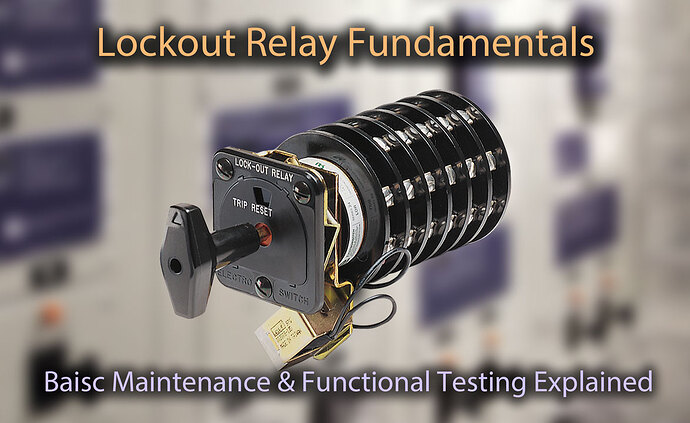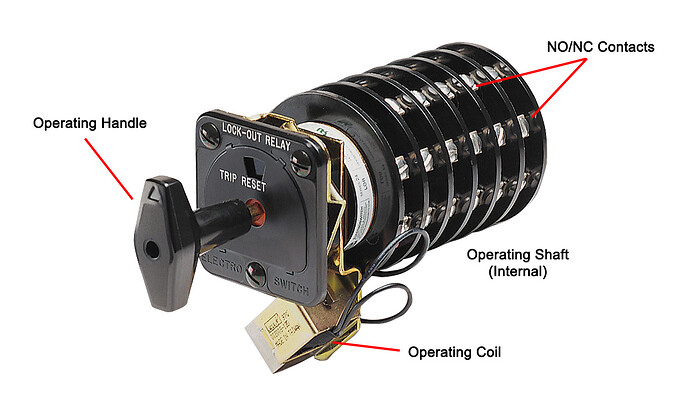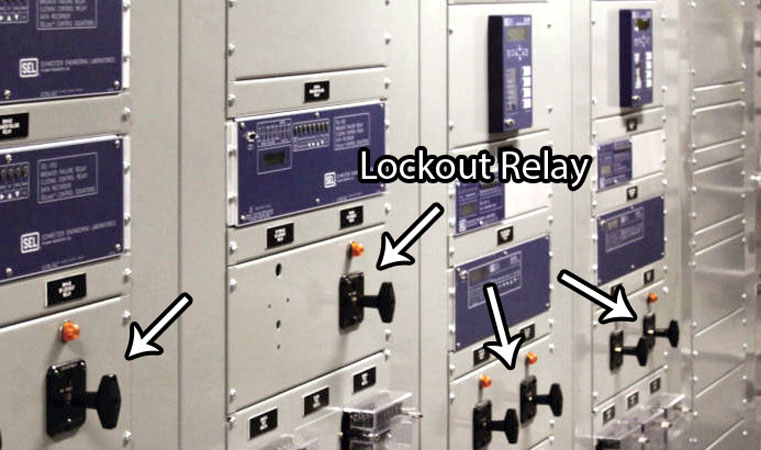Lockout relays play a critical role in electrical power substations by disabling and holding a protection zone out of service if there’s a need to inspect or repair a protective relay before the zone can be safely restored to operation.
Ensuring the reliability and proper functioning of lockout relays is essential to safeguarding the integrity of the power system. These relays hold significant importance as electrical control devices within a facility and require regular maintenance.
Instances where a lockout relay fails to trip protective breakers have been identified as the main cause of numerous major power plant incidents, making the damage resulting from system faults even worse.
How Lockout Relays Fail
Lockout relay failures have resulted in numerous serious worker injuries and extensive equipment damage due to system faults. Below, we will discuss some of the most common modes of failure for lockout relays.
Mechanical Stress
Lockout relays incorporate multiple stages (sets of contacts) on the shaft to enhance the number of devices activated when the relay is triggered. However, certain issues related to mechanical stress can hinder their proper functioning.
In some cases, wiring installations might cause a lockout relay to shift or twist, leading to the improper operation of contacts. Additionally, individual loose wires could be pulled from their connectors if they get snagged while opening doors or covers.
Detecting loose wires can be achieved through electrical functional testing, which is the preferred method, or manually operating the relay while closely observing the positions of all contacts.
Another concern arises when crowded wiring obstructs individual contacts during the installation of relay covers. Contacts positioned near the handle tend to operate more reliably than those located at the rear end if the shaft is weak or has deteriorated over time.
Identifying issues with the lockout relay contacts can be accomplished by using an ohm meter to measure the entire set of contacts.
Lack of Exercise
Relays that have been in service for an extended period and are not regularly exercised during routine maintenance are susceptible to spring wear. As they remain charged for several years, the springs gradually weaken, leading to potential issues. One such problem is the failure to fully rotate the shaft, which prevents the contacts from completely closing to trip circuit breakers.
Careful observation of the mechanical operation of the relay can help identify this issue. Regularly exercising relays as part of maintenance is essential to ensure their reliable performance and prevent problems arising from spring wear.
Operating Coils
Lockout relays rely on the electrical activation of a coil to operate, which can be positioned at either end of the shaft. However, there are potential issues related to the coil’s operation:
-
Insulation breakdown of the coil winding can occur if subjected to excessive voltage or current, leading to either a partial or full short of the coil.
-
Mechanical problems in other parts of the control circuit might cause a coil to remain energized for longer than intended. In case of a coil failure, the lockout relay becomes unable to activate and trip circuit breakers.
To ensure proper functioning, lights or relay monitors can be utilized for continuity checks through both the lockout relay coil and breaker trip coil circuit during regular operation. By monitoring these circuits, any potential problems with the operating coils can be identified early on, reducing the risk of relay failures.
Lockout Relay Maintenance Procedures
Warning: Prior to performing any work, always adhere to the appropriate safety standards and perform a job hazard analysis (JHA). Ensure that testing activities do not disrupt normal operations or pose any risk to equipment, unless planned otherwise.
Lockout relays are commonly found in switchgear applications. Indicator lights can be used to monitor the health of the operating coil.
Visual/Mechanical Inspection
For small and accessible apparatus with only dry dirt present, a clean, dry, lint-free cloth or a soft brush can be used to wipe off dirt, which is generally sufficient. Contacts can be sprayed with a no-residue contact cleaner.
If recommended by the manufacturer, moving parts should be lubricated using a greaseless spray lube that does not attract dust and dirt, following the manufacturer’s instructions if necessary.
Related: Cleaning Methods for Electrical Preventive Maintenance
Functional Testing of Lockout Relays
To simulate real-world conditions and verify the lockout relay’s proper operation in its initial state, conducting a functional test is essential. This test ensures that the lockout relay functions as intended, successfully tripping circuit breakers or other protective devices.
To facilitate testing without interfering with other devices, test switches can be installed. These switches allow for the isolation of inputs and outputs, enabling a thorough examination of the lockout relay’s performance independently. This approach ensures the accuracy and reliability of the lockout relay’s function during critical operations.
Test Procedure
-
Initiate a lockout relay trip by activating the protective relay contact while the lockout relays are in the reset position. Whenever possible, it is advisable to conduct secondary injection testing and operate the protective relay associated with the lockout as part of this procedure. If operating the protection relay is not feasible, technicians can simulate contact operation using a simple jumper. However, it is generally not recommended to test lockout relays with the cover removed.
-
After the lockout relay trip, visually and/or electrically verify that the lockout relay has responded to the protective relay action and operated the relevant circuit breaker or device. Ensure proper functioning of each contact in the lockout relay by checking downstream devices for appropriate actions or using an ohmmeter from the relay terminal board.
-
Activate the lockout relay using each corresponding protective device. Once the first comprehensive functional test is completed, it is advisable to leave the lockout relay in the trip position to prevent burning open the operating coil from repeated operations. Use indicators like meters, lights, buzzers, or other suitable methods to verify the proper functioning of the contacts.
-
Visually inspect all alarms, meters, lights, and other indicators to ensure they have been activated. Return all devices and wiring to their normal positions.
-
Conduct a timing test on the lockout relays. If, at any point, the lockout relay has tripped but the associated breakers have not opened, it indicates a malfunction in the lockout-to-breaker circuit.
Caution: Exercise extreme care to ensure that test switches are correctly positioned for testing (to prevent inadvertent trips), and remember to return them to their normal position when reinstating the system; otherwise, the protection may be disabled.
Additional Trip Coil Tests
Verify the operation of breaker trip coils and other devices controlled by the relay at voltages significantly below normal levels (around 56% of the normal voltage for breaker trip coils). For instance, on a 120 VDC system, this value would be approximately 70 volts. Technicians should also examine the voltage drop in trip circuits and tripping current as part of the testing process.
Conducting these tests ensures that the trip coils and associated devices perform optimally even under reduced voltage conditions, providing an added layer of reliability and safety in critical operational scenarios.
Summary
Lockout relays are vital components in electrical power substations, serving to disable and hold protection zones out of service for inspection and repair of protective relays. Regular maintenance and functional testing are essential to ensure their reliable operation.
Mechanical stress, lack of exercise, and issues with operating coils can lead to lockout relay failures, potentially causing serious worker injuries and equipment damage. By conducting visual and electrical inspections, functional tests, and timing checks, technicians can detect and address potential problems proactively.
Additionally, verifying trip coil operation at reduced voltages further enhances the reliability of lockout relays during critical operations. Remember always to follow safety standards and perform job hazard analysis to safeguard personnel and equipment during lockout relay maintenance procedures.



